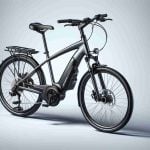The recent expiration of Section 301 tariffs exclusions has raised concerns about the potential increase in the cost of e-bikes. While it is true that imported kids’ bikes, carbon fiber bikes, and e-bikes from China will now be subject to an additional 25 percent duty, the impact on prices may not be as drastic as some fear.
It is important to note that approximately 95 percent of bicycles sold in the U.S. over the last decade were made in China. However, not all e-bike brands will be equally affected by the tariffs. Larger bike companies have already diversified their production and sourcing, moving away from China to countries like Taiwan and Vietnam. This means they won’t face significant issues with these tariffs in the medium to long term.
Additionally, some e-bike drivetrain manufacturers produce their systems outside of China. Companies like Bosch, Fazua, and Mahle produce their components in countries like Germany and Slovenia. While the batteries and bikes themselves often come from China, these manufacturers may be able to avoid the Section 301 tariffs.
That being said, smaller e-bike companies, which heavily rely on Chinese manufacturing due to lower minimum order quantities (MOQs), may face challenges. The imposition of a 25 percent tariff could significantly burden these upstart companies and lead to price increases in the short term.
The effects of the tariffs on e-bike prices also depend on whether batteries and electric components are included. Currently, tariffs are directed towards these specific components made in China. However, the lack of an official delineation for e-bike batteries by the U.S. Trade Representative complicates matters. Until a clear definition is established, manufacturers are left uncertain about the applicability of the tariffs.
While it is difficult to predict the exact impact, one thing is clear: the cost of e-bikes may not skyrocket by 25 percent across the board. The industry will need to adapt and explore alternative production locations or supply chains to ensure accessibility and affordability for consumers.
In conclusion, the expiration of Section 301 tariffs exclusions may result in price increases for certain e-bikes, particularly those from China. However, the actual impact will vary depending on the size and diversification strategies of each e-bike company. By exploring alternative manufacturing locations and supply chains, the industry can mitigate potential price hikes and continue to make e-bikes accessible to a wider market.
The e-bike industry has experienced growing concerns regarding the recent expiration of Section 301 tariffs exclusions, which could potentially lead to increased costs for consumers. However, it is important to note that the impact on prices may not be as severe as some fear.
China has been the primary source for approximately 95 percent of bicycles sold in the U.S. over the last decade. This includes e-bikes, kids’ bikes, and carbon fiber bikes. However, larger bike companies have already taken steps to diversify their production and sourcing, moving away from China to countries like Taiwan and Vietnam. As a result, they will not be significantly affected by the tariffs, ensuring stable pricing in the medium to long term [source].
Furthermore, some e-bike drivetrain manufacturers, such as Bosch, Fazua, and Mahle, produce their components outside of China, particularly in countries like Germany and Slovenia [source]. While the batteries and bikes themselves often come from China, these manufacturers may potentially bypass the Section 301 tariffs.
However, smaller e-bike companies heavily relying on Chinese manufacturing due to lower minimum order quantities (MOQs) may face significant challenges. The increase in tariffs by 25 percent could place a considerable burden on these newer companies and result in short-term price increases [source].
Another factor contributing to the uncertainty surrounding the impact of tariffs on e-bike prices is the inclusion of batteries and electric components. At present, tariffs target these specific components made in China. However, the lack of an official delineation for e-bike batteries by the U.S. Trade Representative complicates matters. Manufacturers are left uncertain about the applicability of the tariffs until a clear definition is established.
While it is challenging to predict the exact impact on prices, it is clear that the cost of e-bikes may not experience a wholesale increase of 25 percent. The industry will need to adapt by exploring alternative production locations and supply chains, ensuring continued accessibility and affordability for consumers [source].
In conclusion, the expiration of Section 301 tariffs exclusions has the potential to impact the prices of e-bikes, particularly those imported from China. However, the actual extent of the impact will depend on the size and diversification strategies of each individual e-bike company. By exploring alternative manufacturing locations and supply chains, the industry can mitigate potential price hikes and ensure the continued accessibility of e-bikes to a wider market.














